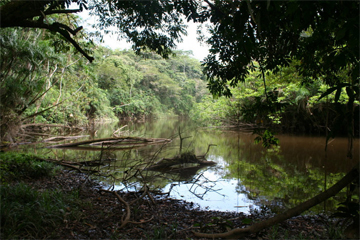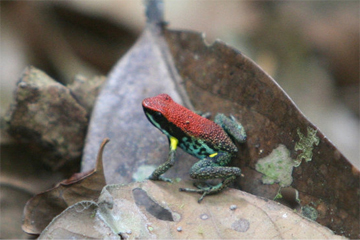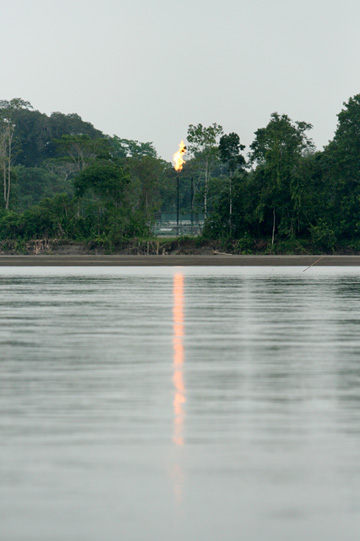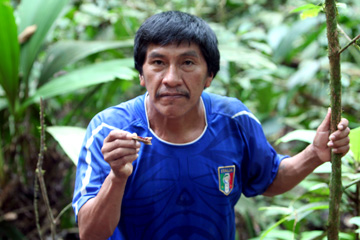An interview with David Romo Vallejos.
Ecuador’s big idea—potentially Earth-rattling—goes something like this: the international community pays the small South American nation not to drill for nearly a billion barrels of oil in a massive block of Yasuni National Park. While Ecuador receives hundreds of millions in an UN-backed fund, what does the international community receive? Arguably the world’s most biodiverse rainforest is saved from oil extraction, two indigenous tribes’ requests to be left uncontacted are respected, and some 400 million metric tons of CO2 is not emitted from burning the oil. In other words, the international community is being asked to put money where its mouth is on climate change, indigenous rights, and biodiversity loss.
 David Romo Vallejo. |
In an interview, David Romo Vallejo, professor at the University of San Francisco Quito and co-director of Tiputini research station in Yasuni, recently told mongabay.com that this is “the best proposal so far made to ensure the protection of this incredible site.”
He adds that the plan, dubbed the Yasuni-ITT Initiative, could have global consequences: “[It is] a very important message that we Ecuadorians are sending to the World since we are trying to demonstrate that there is an alternative to extractivism.”
Still, the initiative isn’t moving quickly or boldly enough, according to Romo Vallejo. He says there is “a lack of strong determination” from the Ecuadorian government.
“Our president should be out there in charge of the negotiations, but instead he put the vice-president in charge. We need support also from countries like the US, and some European countries,” he says.
Over the years the initiative has been plagued with ups and downs. Several times cancellation of Yasuni-ITT seemed imminent. As of today the initiative still stands, but it needs financial backing—and a lot of it—if it’s not to fail. Ecuador is asking for $100 million by the end of 2011 and $3.6 billion in total.
Oil and Ecuador have long been uneasy bedfellows. While oil is one of the backbones of the Ecuadorian economy, it has come with a host of environmental and social problems: from deforestation to pollution to conflict with indigenous tribes.
 An oxbow lake in Yasuni National Park, home to anacondas, piranhas, electric eels, and freshwater stingrays. Photo by Jeremy Hance. |
Romo Vallejo, who works with indigenous groups in the Yasuni region, says that they have faced the brunt of harm from the quest for black gold. Oil in the region has forced indigenous people to speed up the “acculturation process” according to Romo Vallejo.
“Local peoples are forced to change their normal behavior and they are not able to go back to what they used to be. This is by far the worst problem since many of these people end up using the forest to fulfill their new needs and their damage is almost impossible to change or stop.”
The arrival of big oil in Yasuni has made it so there is “no going back for the Kichwa or the Waorani,” Romo Vallejo says. “They know it, but most NGOs, development agencies and the local and country government just do not see this.”
Given that the damage is done for these indigenous groups, Romo Vallejo says what is needed now are investments in education for the indigenous people so they can decide their own fate.
In a November 2010 interview with mongabay.com, David Romo Vallejo talked with mongabay.com about the Yasuni-ITT Initiative, the impacts of the oil industry in Ecuador, and the difficulties facing indigenous groups.
INTERVIEW WITH DAVID ROMO VALLEJO
Mongabay: What is your background?
David Romo Vallejo: I have a Ph.D. in Conservation Biology from University of Minnesota. I am the co-director for Tiputini Biodiversity Station [in Yasuni National Park], and Director of the Ethnic Diversity Program of University San Francisco, Quito.
Mongabay: Why is Yasuni National Park important?
 Poison dart frog in Yasuni National Park. Photo by Jeremy Hance. |
David Romo Vallejo: Right now we have enough scientific data to demonstrate that this is the most diverse place per unit area in the planet. Diversity here is higher than similar locations in the Amazon Basin. It is also the home of people in voluntary isolation, several families of the Waorani, some known as the Tagaeri and the Taromenane.
Mongabay: In your words what is the Yasuni-ITT initiative?
David Romo Vallejo: The best proposal so far made to ensure the protection of this incredible site. It is also a very important message that we Ecuadorians are sending to the World since we are trying to demonstrate that there is an alternative to extractivism.
Mongabay: What are the obstacles remaining to the Yasuni-ITT Initiative?
David Romo Vallejo: At this very moment I think a lack of strong determination from our government. Our president should be out there in charge of the negotiations, but instead he put the vice-president in charge. We need support also from countries like the US, and some European countries.
Mongabay: How optimistic are you that the Yasuni-ITT initiative will succeed?
David Romo Vallejo: Not much…again not due to lack of interest from the countries that can contribute to the initiative, but to the weak message being sent by our government.
Mongabay: Even with the Yasuni-ITT initiative will companies still be drilling for oil in Yasuni National Park?
David Romo Vallejo: If the ITT initiative goes, there is a good possibility that no more drilling will occur in Yasuní since it will make a very poor business. Right now, the pressure to develop other sites is to get closer to the ITT block.
Mongabay: Do you think this initiative could lead to similar projects in South America? Worldwide?
David Romo Vallejo: Definitely.
OIL IN THE AMAZON
Mongabay: What are the immediate impacts of oil exploration and exploitation in a rainforest ecosystem?
 Gas flare at an oil refinery across the river from Yasuni National Park and near Coca. Photo by Jeremy Hance. |
David Romo Vallejo: There is always the risk of spills, leakage of formation water, and poor environmental management in general.
Mongabay: What are the long term impacts?
David Romo Vallejo: Oil, like any other mining bossiness produces a quick burst in the local economy. Coca [an oil city across the river from Yasuni National Park], for example, is more expensive to live in than Quito or some bigger cities in the highlands. All of it is due to oil money.
Moreover, local peoples are forced to change their normal behavior and they are not able to go back to what they used to be. This is by far the worst problem since many of these people end up using the forest to fulfill their new needs and their damage is almost impossible to change or stop.
Mongabay: How has the oil industry hurt or helped indigenous people in the Yasuni region?
David Romo Vallejo: They have sped up their acculturation process.
Mongabay: What would happen to Ecuador if oil drilling stopped overnight? Is Ecuador too dependent on oil for its economy?
David Romo Vallejo: I do not think it will happen this way. We have other wells and other reserves besides Yasuni´s ITT. But if it happens, we are at a very fragile stage right now.
INDIGENOUS GROUPS
Mongabay: You have spent much of your career working with indigenous groups in Yasuni. What are the challenges for these communities?
 Waorani indigenous guide. Photo by Jeremy Hance. |
David Romo Vallejo: Right now they are very ill prepared to make good, longt-erm decisions. They need very good education: kids that make it to college and even go abroad to prepare themselves to reinvent their societies. There is no going back for the Kichwa or the Waorani. They know it, but most NGO, development agencies and the local and country government just do not see this.
Mongabay: Who is most at fault for the difficulties facing Ecuador’s Amazonian indigenous people: the government, oil companies, society at large, or the communities themselves?
David Romo Vallejo: I blame government the most, then society at large, then oil companies and least the communities. The government should be there to protect the rights and long term wellbeing of every citizen. We just have not seen indigenous people as citizens, but that is a problem with almost 70% of the Ecuadorian population.
Oil companies are guilty because they took a job they should not have done…replace the presence of the government in the lands of indigenous people and peasants…they did this because of their greed and lack of strong morals. They just wanted the money…which is fine…but there is something called corporate responsibility which has not been done adequately in Ecuador
Mongabay: What makes the Sarayacu tribe unique in Ecuador?
David Romo Vallejo: They are a Kichwa community in the south part of the Amazon that have refuse the presence of oil companies and so far they have succeeded.
Mongabay: How do you balance conservation of the Amazon with the legitimate needs of indigenous groups?
David Romo Vallejo: Both can be achieved. Conservation is not about stopping development. We have to work first on educating indigenous people to give them a better understanding of their problems and hope that they will make wise decisions. I think it is possible and I have devoted my work to prove that.
Related articles
A look at Ecuador’s agreement to leave 846 million barrels of oil in the ground
(09/13/2010) Ecuador’s pioneering initiative to voluntarily leave nearly a billion barrels of oil under Yasuní National Park, an Amazonian reserve that is arguably the most biodiverse spot on Earth, took a major step forward in early August when the government signed an accord with the United Nations Development Programme (UNDP) for the long-awaited establishment of a trust fund. The signing event generated a wave of international media attention, but there has been very little scrutiny of what was actually signed. Here we present an initial analysis of the signed agreement, along with a brief discussion of some of the potential caveats. Due to the precedent-setting nature of this agreement, attention to the details is now of the utmost importance.
Bold rainforest idea makes good: Ecuador secures trust fund to save park from oil developers

(08/03/2010) In what may amount to a historic moment in the quest to save the world’s rainforests and mitigate climate change, Ecuador and the United Nations Development Fund (UNDF) have created a trust fund to protect one of the world’s most biodiverse rainforests from oil exploration and development. The fund will allow the international community to pay Ecuador to leave an estimated 850 million barrels of oil in Yasuni National Park in the ground instead of extracting it. This first-of-its-kind agreement, known as the Yasuni-ITT Initiative, will allow the rainforest protected area to remain pristine: preserving one of the most species-rich places on Earth, safeguarding the lives of indigenous people, and keeping an estimated 410 million tons of CO2 out of the atmosphere.
Oil devastates indigenous tribes from the Amazon to the Gulf

(07/27/2010) For the past few months, the mainstream media has focused on the environmental and technical dimensions of the Gulf mess. While that’s certainly important, reporters have ignored a crucial aspect of the BP spill: cultural extermination and the plight of indigenous peoples. Recently, the issue was highlighted when Louisiana Gulf residents in the town of Dulac received some unfamiliar visitors: Cofán Indians and others from the Amazon jungle. What could have prompted these indigenous peoples to travel so far from their native South America? Victims of the criminal oil industry, the Cofán are cultural survivors. Intent on helping others avoid their own unfortunate fate, the Indians shared their experiences and insights with members of the United Houma Nation who have been wondering how they will ever preserve their way of life in the face of BP’s oil spill.
Photos: park in Ecuador likely contains world’s highest biodiversity, but threatened by oil

(01/19/2010) In the midst of a seesaw political battle to save Yasuni National Park from oil developers, scientists have announced that this park in Ecuador houses more species than anywhere else in South America—and maybe the world. “Yasuní is at the center of a small zone where South America’s amphibians, birds, mammals, and vascular plants all reach maximum diversity,” Dr. Clinton Jenkins of the University of Maryland said in a press release. “We dubbed this area the ‘quadruple richness center.'”
Ecuador to be paid to leave oil in the ground
(12/23/2009) Ecuador will establish a trust fund for receiving payments to leave oil reserves unexploited in Yasuni National Park, one of the world’s most biodiverse rainforest reserves, reports the UN Development Programme, the agency that will administer the fund.
Will Ecuador’s plan to raise money for not drilling oil in the Amazon succeed?
(10/27/2009) Ecuador’s Yasuni National Park is full of wealth: it is one of the richest places on earth in terms of biodiversity; it is home to the indigenous Waorani people, as well as several uncontacted tribes; and the park’s forest and soil provides a massive carbon sink. However, Yasuni National Park also sits on wealth of a different kind: one billion barrels of oil remain locked under the pristine rainforest.
Oil road transforms indigenous nomadic hunters into commercial poachers in the Ecuadorian Amazon

(09/13/2009) The documentary Crude opened this weekend in New York, while the film shows the direct impact of the oil industry on indigenous groups a new study proves that the presence of oil companies can have subtler, but still major impacts, on indigenous groups and the ecosystems in which they live. In Ecuador’s Yasuni National Park—comprising 982,000 hectares of what the researchers call “one of the most species diverse forests in the world”—the presence of an oil company has disrupted the lives of the Waorani and the Kichwa peoples, and the rich abundance of wildlife living within the forest.
Amazon tribes have long fought bloody battles against big oil in Ecuador

(09/03/2009) The promotional efforts ahead of the upcoming release of the film Crude have helped raise awareness of the plight of thousands of Ecuadorians who have suffered from environmental damages wrought by oil companies. But while Crude focuses on the relatively recent history of oil development in the Ecuadorean Amazon (specifically the fallout from Texaco’s operations during 1968-1992), conflict between oil companies and indigenous forest dwellers dates back to the 1940s.